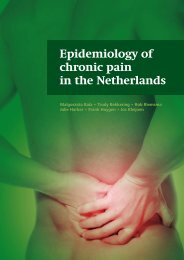First EFIC® Symposium Societal Impact of Pain - SIP
First EFIC® Symposium Societal Impact of Pain - SIP
First EFIC® Symposium Societal Impact of Pain - SIP
You also want an ePaper? Increase the reach of your titles
YUMPU automatically turns print PDFs into web optimized ePapers that Google loves.
90<br />
Thomas R. Tölle<br />
Pr<strong>of</strong>. Dr. med. Dr. med. habil. Dr. rer.nat.<br />
Thomas R. Tölle is a neurologist and psychologist.<br />
Outcome measures in back pain: objective<br />
measurement <strong>of</strong> motor performance <strong>of</strong> the<br />
back with a spine sensor<br />
Thomas R. Tölle (1) and Dirk David Goldbeck (2)<br />
1 Dept. <strong>of</strong> Neurology, Technische Universität<br />
München; 2 OsteoDynamiX GmbH, München<br />
A main target in the treatment <strong>of</strong> low back<br />
pain is the reduction <strong>of</strong> pain. However, for<br />
payers and reimbursement authorities the<br />
restoration <strong>of</strong> functionality and productivity is a<br />
likewise important outcome. Clinical trials on<br />
back pain use a variety <strong>of</strong> psychometric tests,<br />
including patients satisfaction and quality-<strong>of</strong>-life<br />
parameters, and back pain related tools such<br />
as Oswestry- or Roland-Morris-Disability<br />
questionnaires to depict the status and the<br />
overall improvement <strong>of</strong> the patient. In respect<br />
to function and motor performance, the<br />
clinical orthopedic/neurological examination is<br />
standard. Functional tests in physiotherapy,<br />
strength tests or work-related performance<br />
are occasionally utilized to gather more<br />
detailed information on the functional capacity<br />
<strong>of</strong> the patient. If it comes to the currently<br />
available outcome measures in back pain, we<br />
have to face an unquestionable mismatch<br />
between the measurement <strong>of</strong> subjective<br />
experience <strong>of</strong> pain and well-being with objective<br />
motor performance <strong>of</strong> back function. This can<br />
weaken the overall appraisal <strong>of</strong> any pharmaco-,<br />
physio- or cognitive therapy intended to<br />
improve “pain and function” in this group <strong>of</strong><br />
patients.<br />
Although the satisfaction <strong>of</strong> a patient is an<br />
important subjective yardstick, a next target<br />
should be the establishment <strong>of</strong> a more<br />
objective measure <strong>of</strong> function. This can be<br />
achieved by developing a specific technology<br />
that measures real improvement <strong>of</strong> function,<br />
e.g. with respect to a pre-specified set <strong>of</strong><br />
exercises. Preferably, this tool measures<br />
velocity and mobility with high resolution <strong>of</strong><br />
space and time.<br />
We are now able to report a new system<br />
(Spine Sensor from OsteoDynamiX GmbH, a<br />
spin-<strong>of</strong>f <strong>of</strong> Siemens AG) for in-vivo real-time<br />
assessment <strong>of</strong> motor performance in low<br />
back pain. The system is able to continuously<br />
record motion in the lumbar part <strong>of</strong> the<br />
vertebral column regarding flexion, extension<br />
and rotation, and store the generated data<br />
with a high sampling rate (50 Hz) making it<br />
possible to evaluate a broad range <strong>of</strong> basal<br />
motion. Measurement <strong>of</strong> function was<br />
ascertained from the dynamics <strong>of</strong> motion in<br />
recordings <strong>of</strong> day-to-day life and from a<br />
supervised motion choreography allowing for<br />
several post-analysis steps. Our pilot study<br />
results have methodological and substantial<br />
implications for the study <strong>of</strong> back pain. We<br />
could demonstrate high reliability <strong>of</strong> shortterm<br />
and long-term measurements that is<br />
superior to the modest reliability <strong>of</strong> existing<br />
measurements in this area.<br />
Hence, a new assessment <strong>of</strong> the efficiency <strong>of</strong><br />
therapeutic procedures in the future using this<br />
OsteoDynamiX Spine Sensor system is likely to<br />
be <strong>of</strong> immediate use not only for patients, but<br />
also for cost units. New developments in<br />
diagnostics and therapy monitoring are<br />
currently emerging with application <strong>of</strong> the tool<br />
in healthy controls and back pain patients. .






